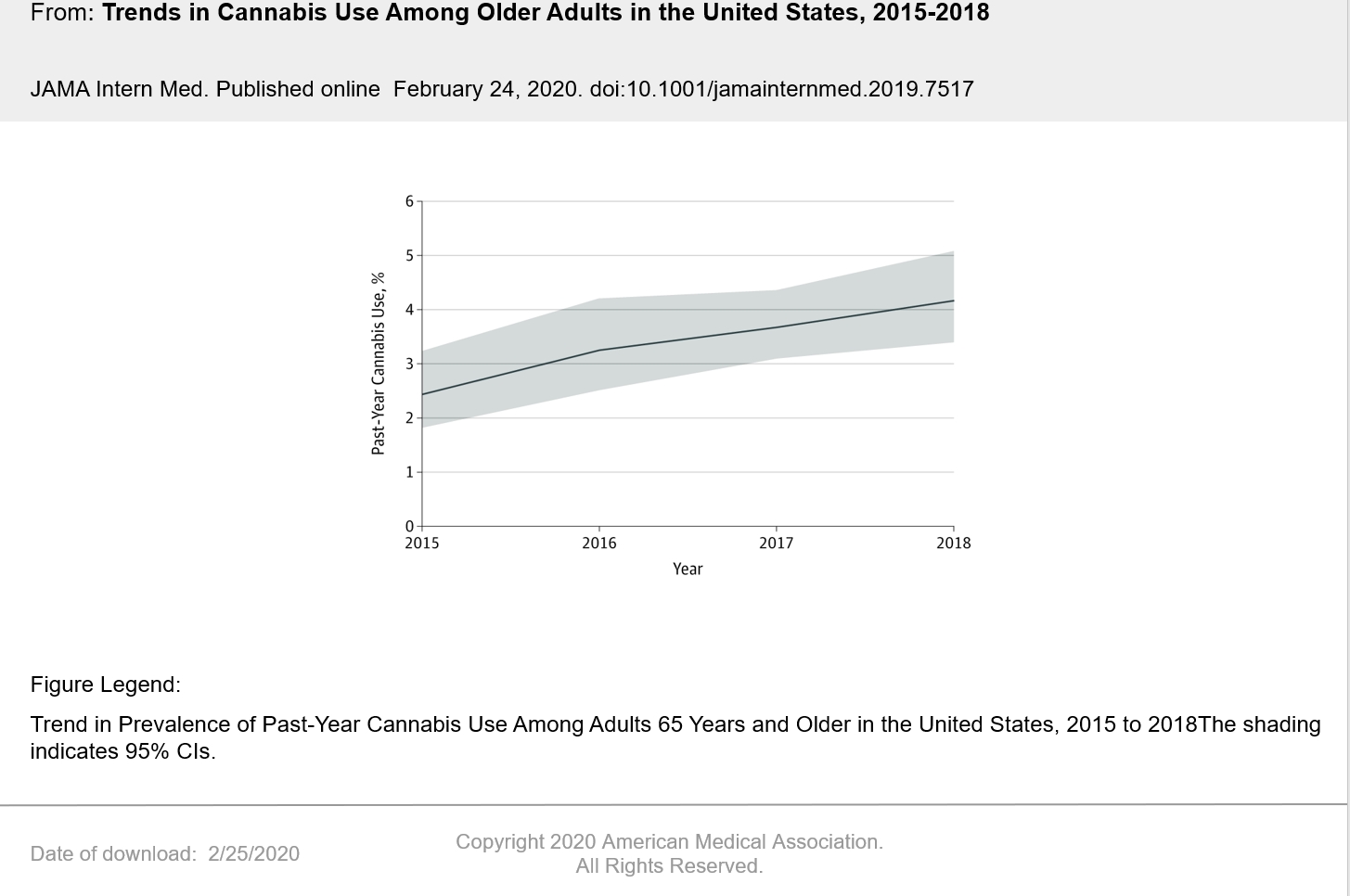Trends in Cannabis Use Among Older Adults in the United States, 2015-2018
Benjamin H. Han, JAMA Intern Med. Published online February 24, 2020.
With the legalization of cannabis in many states for medical and/or recreational purposes, there is increasing interest in using cannabis to treat a variety of long-term health conditions and symptoms common among older adults. The use of cannabis in the past year by adults 65 years and older in the United States increased sharply from 0.4% in 2006 and 2007 to 2.9% in 2015 and 2016.1,2 This study examines the most recent national trends in cannabis use to determine whether cannabis use has continued to increase among older adults and to further examine trends in use among subgroups of older adults.
Methods
We performed secondary analysis of adults 65 years and older from the most recent 4 cohorts (2015-2018) of the National Survey on Drug Use and Health, a cross-sectional nationally representative survey of noninstitutionalized individuals in the United States.3 We estimated the prevalence of past-year cannabis use across cohorts and estimated prevalence stratified by each level of sex, race/ethnicity, educational attainment, household income, marital status, chronic disease, tobacco and alcohol use, mental health treatment, and all-cause emergency department use. Cannabis use was ascertained by asking about marijuana, hashish, pot, grass, and hash oil use either smoked or ingested.3 We calculated the absolute and relative change in prevalence between 2015 and 2018. Using logistic regression, we estimated whether there was a log-linear association between cannabis use and time, and interactions were examined to determine changes across subgroups. Statistical significance was defined as a 2-sided P value less than .05. We used sample weights (provided by National Survey on Drug Use and Health) to account for the complex survey design, selection probability, nonresponse, and population distribution. This secondary analysis was exempt from review by the New York University’s institutional review board. Analyses were conducted using Stata/SE version 13 (StataCorp).
Results
Of 14 896 respondents 65 years and older, 55.2% were men and 77.1% were white. The prevalence of past-year cannabis use among adults 65 years and older increased significantly from 2.4% to 4.2% (P = .001), a 75% relative increase (Figure). The Table presents prevalence trends stratified by participant characteristics. There were significant increases among women, individuals of white and nonwhite races/ethnicities, individuals with a college education, individuals with incomes of $20 000 to $49 000 and $75 000 or greater, and married individuals. In terms of chronic disease, among adults with diabetes, there was a 180% relative increase (1.0% [95% CI, 0.5-2.1] in 2015 vs 2.8% [95% CI, 1.7-4.7] in 2018; P = .02) in cannabis use. Individuals reporting 1 or less chronic diseases had a significant relative increase in cannabis use of 95.8% (2.4% [95% CI, 1.8-3.2] in 2015 vs 4.7% [95% CI, 3.6-6.2] in 2018; P < .001). Those who received mental health treatment also had a significant increase in cannabis use (2.8% [95% CI, 1.3-5.9] in 2015 vs 7.2% [95% CI, 4.8-10.5] in 2018; 157.1% relative increase; P = .02) as well as those reporting past-year alcohol use (2.9% [95% CI, 2.2-4.0] in 2015 vs 6.3% [95% CI, 5.0-8.0] in 2018; 117.2% relative increase; P < .001).














